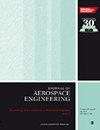基于延迟分离涡模拟和非定常Reynolds平均Navier-Stokes的炮塔周围气动光学效应数值研究
IF 1.1
4区 工程技术
Q3 ENGINEERING, AEROSPACE
Proceedings of the Institution of Mechanical Engineers Part G-Journal of Aerospace Engineering
Pub Date : 2023-10-17
DOI:10.1177/09544100231207568
引用次数: 0
摘要
采用延迟分离涡模拟(DDES)和非定常雷诺平均纳维-斯托克斯(URANS),基于两方程剪切应力输运(SST)模型,研究了转塔周围的流动特征和气动光学畸变。马赫数Ma = 0.4,雷诺数Re = 1.43 × 10.6。给出了瞬时流场和时均流场,比较了DDES和URANS预测流场特征的能力。瞬时结果表明,与URANS相比,DDES可以解决丰富的流动结构和更无序的密度分布。两种方法的时均压力系数和密度分布大致相似,但URANS的时均湍流动能远高于DDES。DDES的时间平均压力系数更接近实验数据。在迎风视图中,DDES和URANS的典型表面流动特征相似。在背风面,DDES和URANS的典型流动特征存在显著差异。在60°、76°、90°、103°、120°和132°6个仰角下,分别用几何射线追踪法和Zernike多项式拟合计算并讨论了时空波前畸变。在空间分布上,DDES和URANS的波前畸变与实验数据略有不同。在60°、76°、90°和103°角度下,DDES在不同示踪距离下的波前畸变趋势与URANS相同,这是由于两种方法对附著流区密度分布的解析能力相同。在120°和132°角处,DDES的结果与实验结果吻合较好,且比URANS的结果大。在时间特征上,DDES的波前畸变频率明显高于URANS。DDES的波前畸变幅度约为URANS的3 ~ 5倍。当Ma = 0.4时,两种不同FLHs的流动结构完全相似,波前畸变随θ的变化趋势也相似。在3马赫数情况下,压缩对波前畸变影响较大。本文章由计算机程序翻译,如有差异,请以英文原文为准。
Numerical investigation of aero-optical effects around the turret based on delayed detached eddy simulation and unsteady Reynolds averaged Navier-Stokes
Delayed Detached Eddy Simulation (DDES) and Unsteady Reynolds Averaged Navier-Stokes (URANS), based on the two-equation Shear Stress Transport (SST) model, are implemented to investigate the flow features and the aero-optical distortions around the turret. The Mach number is Ma = 0.4 and the Reynolds number is Re = 1.43 × 10 6 . Instantaneous and time-averaged flow fields are presented to compare the ability of DDES and URANS in predicting the flow features. The instantaneous results show that DDES can resolve the abundant flow structures and more disordered density distributions than URANS. The time-averaged pressure coefficient and the density distribution of both methods are generally similar, but the time-averaged turbulent kinetic energy of URANS is far higher than that of DDES. The time-averaged pressure coefficient of DDES is closer to experimental data. In the windward view, typical surface flow features of DDES and URANS are similar. In the leeward view, there are remarkable differences of typical flow features between DDES and URANS. At the six angles of elevation, 60°, 76°, 90°, 103°, 120°, and 132°, the spatial-temporal wavefront distortions are calculated and discussed with the geometric ray-tracing method and the Zernike polynomial fitting, respectively. In spatial distribution, the wavefront distortions of DDES and URANS are slightly different from the experimental data. At the angles of 60°, 76°, 90°, and 103°, the tendencies of wavefront distortion of DDES at different tracing distances are the same with that of URANS, which is due to the same ability of two methods to resolve the density distributions in the attached flow region. However, the results of DDES agree well with the experimental results at the angles of 120° and 132°, which is bigger than the results of URANS. For temporal characteristics, the frequencies of wavefront distortions of DDES are obviously higher than that of URANS. The amplitudes of wavefront distortions by DDES are about 3 to 5 times higher than that by URANS. At the cases of two different FLHs at Ma = 0.4, the flow structures are totally similar, and the tendencies of wavefront distortion with θ are also similar. At the cases of three Mach number, the compression has a big influence on the wavefront distortion.
求助全文
通过发布文献求助,成功后即可免费获取论文全文。
去求助
来源期刊

CiteScore
2.40
自引率
18.20%
发文量
212
审稿时长
5.7 months
期刊介绍:
The Journal of Aerospace Engineering is dedicated to the publication of high quality research in all branches of applied sciences and technology dealing with aircraft and spacecraft, and their support systems. "Our authorship is truly international and all efforts are made to ensure that each paper is presented in the best possible way and reaches a wide audience.
"The Editorial Board is composed of recognized experts representing the technical communities of fifteen countries. The Board Members work in close cooperation with the editors, reviewers, and authors to achieve a consistent standard of well written and presented papers."Professor Rodrigo Martinez-Val, Universidad Politécnica de Madrid, Spain
This journal is a member of the Committee on Publication Ethics (COPE).
 求助内容:
求助内容: 应助结果提醒方式:
应助结果提醒方式:


